Samsung Galaxy Tab 10.1 Review: The Sleekest Honeycomb Tablet
by Anand Lal Shimpi on June 13, 2011 5:07 AM EST- Posted in
- Tablets
- Samsung
- Tegra 2
- Galaxy tab 10.1
- Android 3.1
- Mobile
- NVIDIA
A Beautiful Display
Other than form factor, the 10.1's display is the only other major advantage Samsung holds over ASUS. While the Eee Pad's display is quantifiably similar to Apple's iPad 2, it does fall victim to an incredible amount of glare. There's a sizable gap between the LCD panel and the outermost glass, which results in more glare than most other tablets we've reviewed this generation. The 10.1 however doesn't suffer this fate and as a result is more directly comparable to the iPad 2.
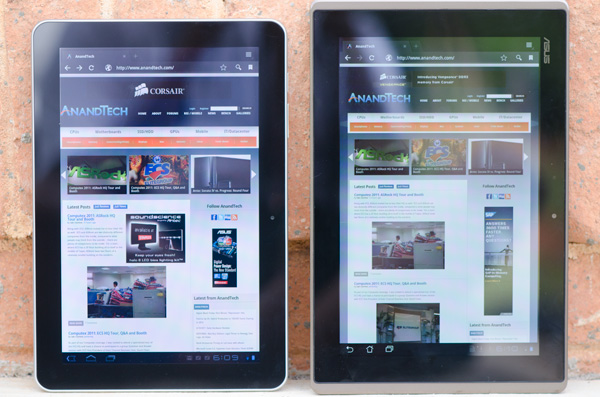
Samsung Galaxy Tab 10.1 (left) vs. ASUS Eee Pad Transformer (right)

Samsung Galaxy Tab 10.1 (left) vs. Apple iPad 2 (right)
While both ASUS and Apple use an IPS panel in their tablets, Samsung uses its own technology called Super PLS (plane line switching). Brian Klug, our resident smartphone and display guru did some digging and it turns out that Super PLS is Samsung's own take on IPS that maintains viewing angle while boosting throughput (brightness). The Samsung supplied photo below shows a comparison of the tradeoff you make with S-IPS and I-IPS, as well as both of those compared to Super PLS:
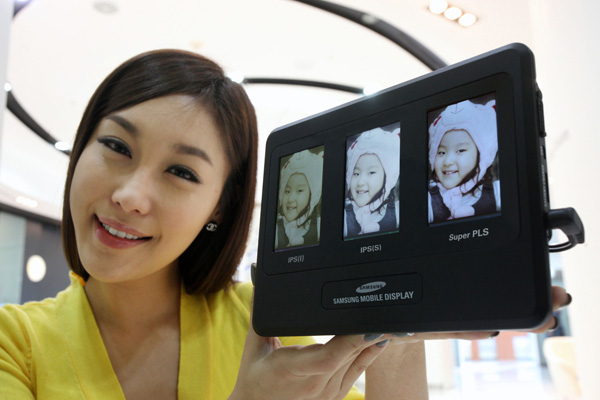
Traditionally you'd have to trade off viewing angle for brightness or vice versa even within the IPS family. Super PLS lets you have your cake and eat it too, giving you the same side viewing angles as S-IPS but with the light throughput of I-IPS.
Perhaps due to the use of Super PLS, Samsung actually managed to outfit the Galaxy Tab 10.1 with a brighter panel than what we saw with the iPad 2. Black levels aren't quite as good but peak brightness is measurably better at nearly 500 nits. While the display isn't what I'd consider bright enough to use in direct sunlight, it is more versatile than the iPad 2's as a result of its brightness.

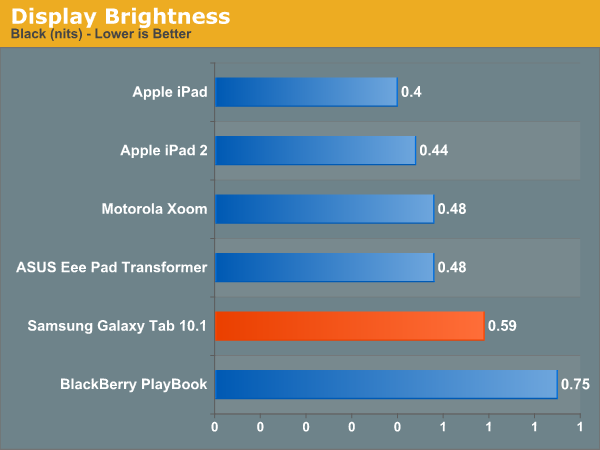
The higher black levels balance out the brighter panel and deliver a contrast ratio comparable to that of the iPad 2:
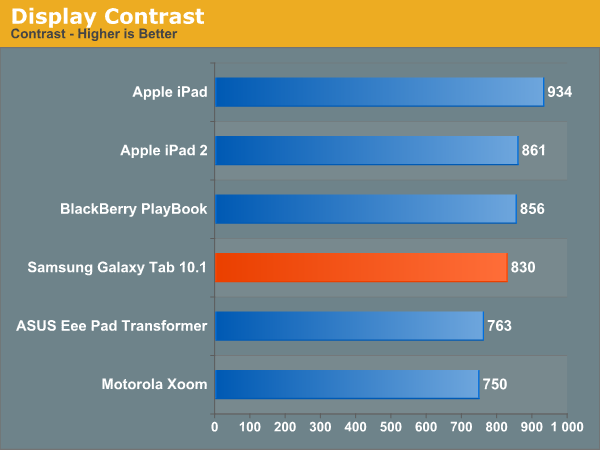
I should mention that the quality of the panel on the retail 10.1 sample is significantly better than what I saw with Samsung's Galaxy Tab 10.1 Limited Edition at Google IO. The sample from IO had noticeably worse black levels, lower peak brightness and as a result lower overall contrast. On top of all of that, the LE suffered light bleed from one of its corners - a problem I haven't seen on the retail 10.1. With only two Galaxy Tabs to compare this is either an indication of wildly varying quality control, or more likely that Samsung simply repackaged its early samples as LEs and saved the mass production hardware for paying customers a month after Google IO.
As you can see in the shot above the Samsung panel has a considerably cooler white point than the Eee Pad Transformer. A quick measure with our colorimeter shows a white point of 8762 (vs 7805K for the Eee Pad). It does make Samsung's default wallpaper look very pretty. If you're wondering, the iPad 2's panel is calibrated to a 6801K white point - at least with our 16GB CDMA sample here.


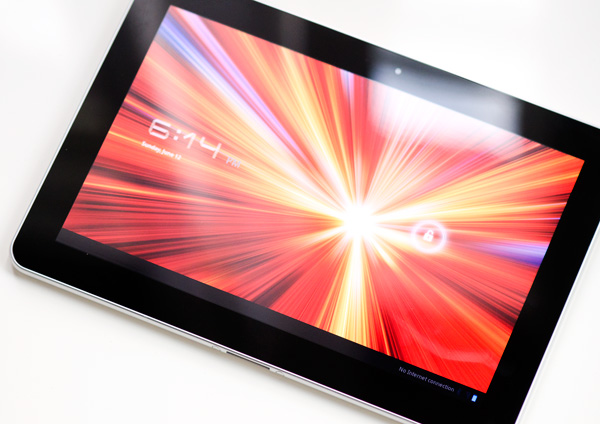
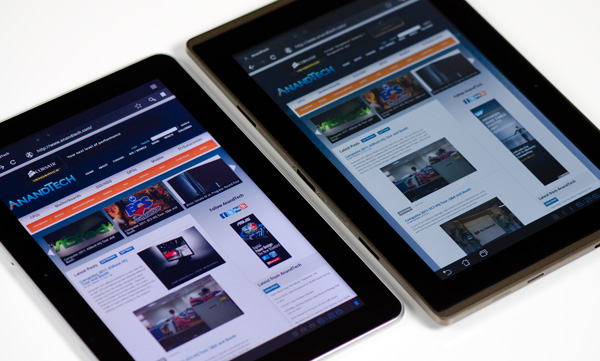








108 Comments
View All Comments
fteoath64 - Wednesday, June 15, 2011 - link
I doubt if Samsung knew very much detail about the physical shape (although they could guess and many have done), panel size and dot-pitch yes, processor no, camera no (its Sony's part), but that hardly constitute "blatant copying" as Apple has accused. One cannot deviate much from a rectangular shape. But the thing that cannot understand is no manufacturer has built rocker switches (like in PocketPC days) that does vertical/horizontal scrolling. This allows the single holding hand to scroll pages which EVERYBODY wanted!!. Samsung are you listening ?. One for landscape use and one for portrait use. There is plenty of space for it. Touch is not everything.Lucian Armasu - Tuesday, June 14, 2011 - link
"Remember Kal-El won't really change single threaded performance"I think I know what you meant - that it would still be Cortex A9. But that doesn't mean performance won't improve. Every core will be clocked at 1.5 Ghz.
And you're right, ARM chips seem to improve 2.5x every 12 months, or about 4x every 18-24 months. That's 2x as fast as Moore's Law. Can't wait until Nvidia unveils their Tegra 4 next year - 2.5 Ghz quad core Cortex A15 ;)
mo.hasan - Tuesday, June 14, 2011 - link
Anand. Very thorough review as always. Great job.Here is a list of accessories available for Samsung 10.1. Currently they are showing up on european websites. Landing in USA soon I suppose.
HDMI cable adapter
SD Adapter
Charging Dock with sound bar
USB Connector Kit
Keyboard
More...
Yes you can have all these ports built in like an Acer Iconia or some in Asus Transformer. Personally I will take the weight savings and slimness versus all those ports built in. In a tablet that is. Notebook however is a whole different story. Plus Samsung's superior display is a slam dunk for me versus any other android tablet at the moment. Kal-El is not worth waiting for unless you are buying a tablet to play games only. Damn you Bestbuy, here is my pre-order.
Mumrik - Tuesday, June 14, 2011 - link
Anand, why does Apple keep having a sizable advantage in battery life? It's the same in tablets and smart phones...The hardware seems to similar to blame, so does Google just do a comparatively bad job at managing power in Android?
Paladin1650 - Wednesday, June 15, 2011 - link
I don't understand the fixation on 10 inch tablets. That is too big to be easily portable without carrying a bag everywhere, and if I'm toting a bag, I might as well bring a laptop with a bigger screen, real keyboard, 300gig+ hard drive, real operating system, real processor, etc. Not to mention the built in stand. My 15 inch laptop is not much thicker or heavier than an iPad.Its too big, bright, and heavy to use like a portable game console or an e-reader (Note: Nintendo never came anywhere close to a 10 inch screen on any of its 50 million plus selling portable consoles). Sure you can goof around on it and have unique experiences...but those experiences aren't going to be lasting dozens of hours like a novel or a serious video game.
Are people actually trying to replace their laptop with a tablet? That is the only usage scenario that makes sense to me for a 10 inch tablet. If you are somehow able to actually type and be productive on a tablet, more power to you.
Now, what DOES make sense to me is a giant smartphone. Smartphones are incredibly useful, more useful for everyday tasks than a laptop, since it has GPS, camera, camcorder, barcode scanner, phone, email, MP3 player etc all rolled into one. However, a 3-4 inch screen is really too small for video content consumption, and doesn't allow much room for touch. Solution? A 5-6 inch jumbo smartphone that behaves exactly like a smartphone, but with a bigger screen. That is what I want (the original galaxy tab comes close, but a bit too large to be pocket sized). So why are we only seeing those from Dell and Samsung, and why does Samsung seem to be switching to larger form-factors? Why is "its just a giant phone" a bad thing? I think in 10 years we will see this size range emerge as the standard for the all-in-one pocket device, and the 10 inch tablet will remain a very niche product.
fteoath64 - Wednesday, June 15, 2011 - link
@Paladin1650: When you look at the kindle, it gives a strong clue. Besides to consume 720p video, 10 inch is about the ,minimum needed to appreciate the quality of the video. Anything smaller, 720p is not going to matter much. For eBook reading and that goes for webpage reading as well, that physical size is really optimum for most people young and old. My only beef is the screen resolution should be 1366X768 and make that IPS at least.Laptop usage is different from tablet significantly from the holding distance from your face to the screen. On a tablet, you hold it much nearer to your face. This means 10inches could instantly equal to 15inch laptop distance. Plus the weight advantage and not frying your lap scenarios, it could be compelling for some.
As to phones going to 5inches, thats already too big for many. iPhone size is about right, and going to 4 inches might be pushing it. I like to see 1680X1050 resolution in 4 inches.
One size fits all does not exist unless thats a body implant using our body fluids as its electrical source. Get that from your friendly grey alien Paul.
araczynski - Wednesday, June 15, 2011 - link
but no point in buying until the second gen comes out later this year, especially since ipad3 will hopefully share some info by then.i'm heavily vested in the itunes app store (i use my ipad1 95% of the time for just gaming), so whatever other neato features the android tablets have are meaningless to me. especially since if i read those last 2 benchmarks the gaming on the android doesn't compare to the gaming on the ipad2.
i still think they're stupid to price it at the same level as the ipads though. you're going against an entrenched/established and in many cases fanatical base of apple users (i have no love for apple, but do love the ipad), you deliver something similar, and you charge it the same, why the hell would i bother to switch? offer me something BETTER.
not to mention 16/32gb of storage is just measly. this IS the digital age after all, we like to dump movies/etc onto these devices. my ipad/64gb is full all the time, and i'm sick of that fact. no way in hell would i downgrade storage.
ps2 - Thursday, June 16, 2011 - link
So, having read this review, it sounds like I would best wait another 6 months to own a tablet. I am getting a galaxy S2 phone in about 6 weeks when it is released, so i probably should wait, but my partner has an IPad 2 and I could have a tablet by tomorrow (I think that's when the 10.1 is being released). Is it worth 5 or $600 to have a tablet for the next six months? I know it's my decision, but I welcome some brilliant geeks advice.ps2 - Thursday, June 16, 2011 - link
So, having read this review, it sounds like I would best wait another 6 months to own a tablet. I am getting a galaxy S2 phone in about 6 weeks when it is released, so i probably should wait, but my partner has an IPad 2 and I could have a tablet by tomorrow (I think that's when the 10.1 is being released). Is it worth 5 or $600 to have a tablet for the next six months? I know it's my decision, but I welcome some brilliant geek's advice. And if I am likely to upgrade in the future (if I buy a tablet now, I won't feel an urge to buy a Kel-al device the second it comes out), should my purchase be an IPad 2 or Galaxy 10.1 (or should I wait two months for an 8.9)?emmib - Friday, June 17, 2011 - link
Would Kal-El seriously make it to market, in an Android tablet, within the next 4-5 months? The best scenario I can see is an announcement in 4 months time, in the fall, then release either by the holiday season, or within a couple of months after that.What's truly best? Wait, or get a tablet now? I don't really care for graphics performance as not many games and such are available in my region anyway.